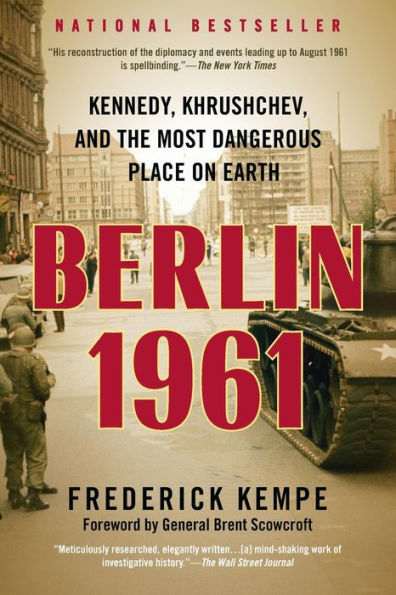In June 1961, Nikita Khrushchev called Berlin "the most dangerous place on earth." He knew what he was talking about.
Much has been written about the Cuban Missile Crisis a year later, but the Berlin Crisis of 1961 was more decisive in shaping the Cold War-and more perilous. It was in that hot summer that the Berlin Wall was constructed, which would divide the world for another twenty-eight years. Then two months later, and for the first time in history, American and Soviet fighting men and tanks stood arrayed against each other, only yards apart. One mistake, one nervous soldier, one overzealous commander-and the tripwire would be sprung for a war that could go nuclear in a heartbeat.
On one side was a young, untested U.S. president still reeling from the Bay of Pigs disaster and a humiliating summit meeting that left him grasping for ways to respond. It would add up to be one of the worst first-year foreign policy performances of any modern president. On the other side, a Soviet premier hemmed in by the Chinese, East Germans, and hardliners in his own government. With an all-important Party Congress approaching, he knew Berlin meant the difference not only for the Kremlin's hold on its empire-but for his own hold on the Kremlin.
Neither man really understood the other, both tried cynically to manipulate events. And so, week by week, they crept closer to the brink.
Based on a wealth of new documents and interviews, filled with fresh-sometimes startling-insights, written with immediacy and drama, Berlin 1961 is an extraordinary look at key events of the twentieth century, with powerful applications to these early years of the twenty-first.
Includes photographs
In June 1961, Nikita Khrushchev called Berlin "the most dangerous place on earth." He knew what he was talking about.
Much has been written about the Cuban Missile Crisis a year later, but the Berlin Crisis of 1961 was more decisive in shaping the Cold War-and more perilous. It was in that hot summer that the Berlin Wall was constructed, which would divide the world for another twenty-eight years. Then two months later, and for the first time in history, American and Soviet fighting men and tanks stood arrayed against each other, only yards apart. One mistake, one nervous soldier, one overzealous commander-and the tripwire would be sprung for a war that could go nuclear in a heartbeat.
On one side was a young, untested U.S. president still reeling from the Bay of Pigs disaster and a humiliating summit meeting that left him grasping for ways to respond. It would add up to be one of the worst first-year foreign policy performances of any modern president. On the other side, a Soviet premier hemmed in by the Chinese, East Germans, and hardliners in his own government. With an all-important Party Congress approaching, he knew Berlin meant the difference not only for the Kremlin's hold on its empire-but for his own hold on the Kremlin.
Neither man really understood the other, both tried cynically to manipulate events. And so, week by week, they crept closer to the brink.
Based on a wealth of new documents and interviews, filled with fresh-sometimes startling-insights, written with immediacy and drama, Berlin 1961 is an extraordinary look at key events of the twentieth century, with powerful applications to these early years of the twenty-first.
Includes photographs

Berlin 1961: Kennedy, Khrushchev, and the Most Dangerous Place on Earth
640
Berlin 1961: Kennedy, Khrushchev, and the Most Dangerous Place on Earth
640Related collections and offers

Product Details
| ISBN-13: | 9780425245941 |
|---|---|
| Publisher: | Penguin Publishing Group |
| Publication date: | 01/03/2012 |
| Pages: | 640 |
| Sales rank: | 100,817 |
| Product dimensions: | 6.04(w) x 9.04(h) x 1.10(d) |
| Age Range: | 18 Years |
About the Author
What People are Saying About This
Customer Reviews
Explore More Items
Erik Larson—author of #1 bestseller IN THE GARDEN OF BEASTS—intertwines the true tale of the 1893 World's Fair and the cunning serial killer who used the fair to lure his victims to their
Erik Larson has been widely acclaimed as a master of
In Thunderstruck, Erik Larson tells the interwoven stories of two men—Hawley Crippen, a very
#1 New York Times Bestseller
From the bestselling author and master of narrative nonfiction comes the enthralling story of the sinking of the Lusitania
On May 1, 1915, with WWI entering its tenth
The #1 New York Times bestselling author of The Devil in the White City and Dead Wake delivers a fresh and compelling portrait of Winston Churchill and London during the
This devastating book illuminates America's gun culture — its manufacturers, dealers, buffs, and propagandists — but also offers concrete solutions to our national epidemic of death by
The bestselling author ofThe O'Reilly Factor, The No Spin Zone, and Who's Looking Out for You? talks straight to kids this time. He is as demanding, direct, and wry asever--but he's also more
One day in 1957, in the third-grade classroom of St. Brigid’s parochial school, an exasperated Sister Mary Lurana bent over a restless young William O’Reilly and said, “William, you
Readers around the world have been enthralled by Killing England, Killing the Rising Sun, and Killing Reagan--riveting works of nonfiction that journey into the heart of the most famous murders in
To mark the 70th anniversary of the Spanish Civil War's outbreak, Antony Beevor
